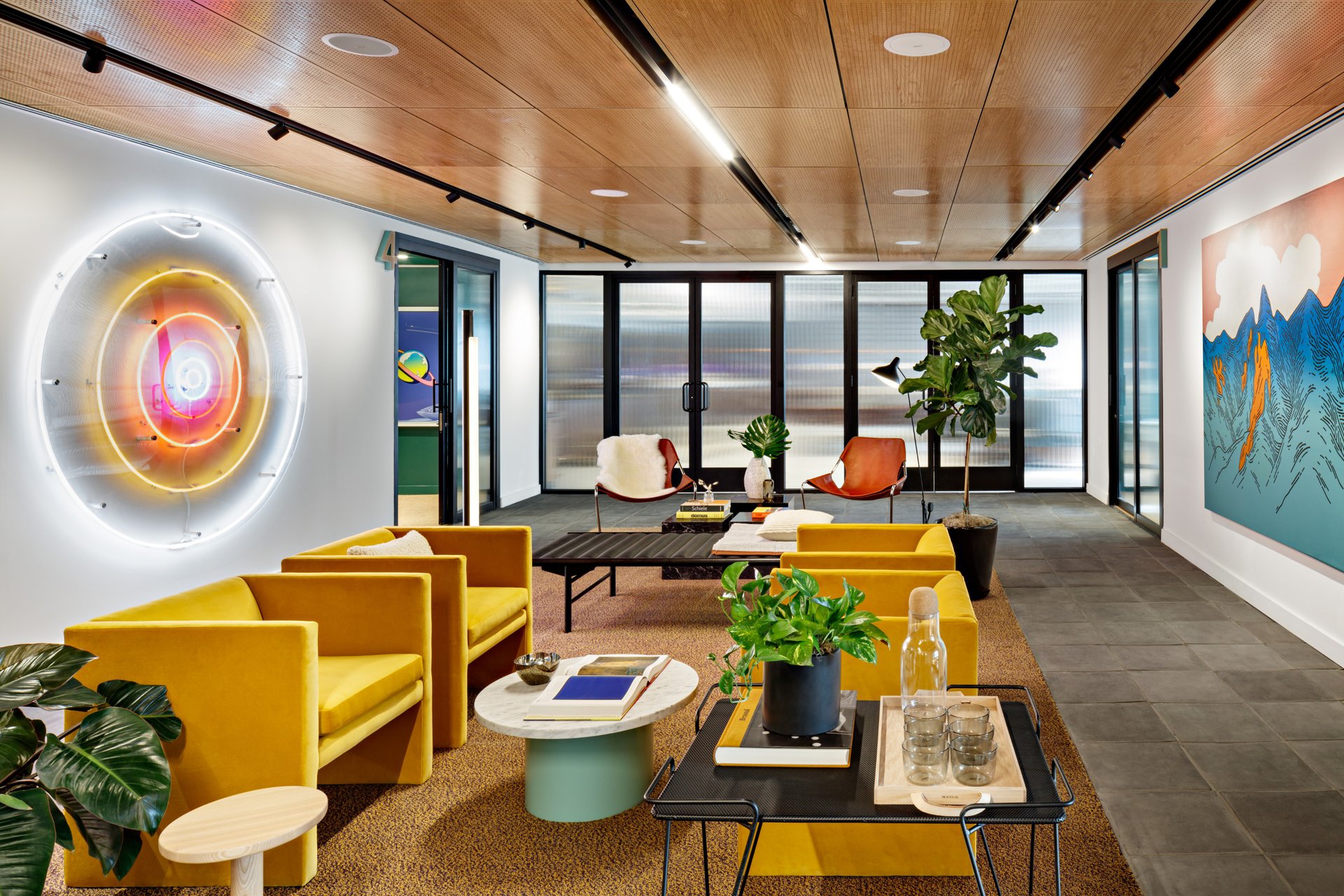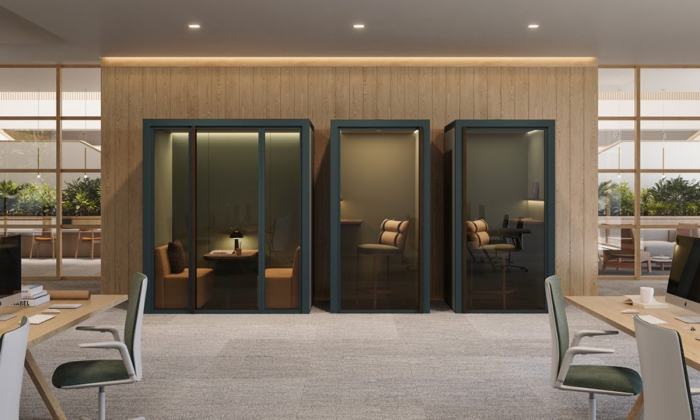Darian Lu shares how hospitality influenced design can help create work environments that focus on employee experience and foster community.

In the past year, employees have faced unprecedented personal and professional struggles. The pandemic has given business leaders increased visibility into employee’s personal lives. They are asked to shift from managing employee’s job to managing work experience. Supporting employees in their personal lives more effectively enables employees to have better lives and perform at a higher level. Companies are learning the expertise from the hospitality industry to better anticipate and address employee needs.
Companies are learning the expertise from the hospitality industry to better anticipate and address employee needs.
For companies to implement return to work policy, basic desires – for one to be recognized, welcomed, entertained, and comfortable to work intensely and collaborate with one another, are now driving the post-pandemic workplace strategies. This is accomplished through careful strategic design and planning beyond traditional approaches. The new approach centers around hospitality, creating a work environment that promotes different forms of connections, personal comfort and employees’ well-being.
Pre-pandemic workplace hospitality trends
The most progressive companies create workplace design solutions from inspirations outside traditional work environments. Companies enhance their culture and branding through unique employee and clients’ arrival experiences, and cross-functioning programs that improve workplace efficiency. At TikTok headquarter in Los Angeles, upon arrival, a unique entry journey is curated through a hallway-long LED screen, showcasing TikTok’s fun and energetic creative contents for both their employees and visitors. The orchestrated first impression draws inspiration from retail designs where guests are immediately wowed and engaged at the company’s business.
The most progressive companies create workplace design solutions from inspirations outside traditional work environments.
Another pre-pandemic trend, which is still commonly adopted, is referred to as “hoteling” where employees use lockers to store their belongings, and leave workstations spotless at the end of their work shifts. The hoteling approach lets companies create multiple shifts without having to expand their office physical footprint, and organize employee seatings based on team assignments without rearranging actual workstations. Companies demanded their employees to stay flexible in the physical space, in order to adapt to company workplace changes. These pre-pandemic approaches manifest brand and culture in the workplace, and generate real estate efficiency.

New workplace design strategies
In this unprecedented time, work-life balance has evolved to work-life integration. To transition employees to work in offices after more than one year of working at home, work space must now satisfy a variety of personal needs. Company-centric workplaces need to shift towards employee-oriented designs. Companies are beginning to see that employee loyalty is linked to how the workplace makes them feel just as much as employees’ job descriptions and the company product or service.
Companies are beginning to see that employee loyalty is linked to how the workplace makes them feel
Bringing the comfort of working from home to the workplace through smart workstation and office prototypes is one way to win employees back. Some workspace pioneers, such as Google R+D Lab and WeWork Creative Studio, fabricated customizable work spaces that support employees who no longer need a permanent place to sit. At a swipe of company badge or log into company portal, a personalized setting will be calibrated to adjust preferred desk height, bringing up family photos on a display, turning on preferred background music at the volume of one’s choice. Mood light and surrounding temperature may also be adjusted to accommodate individual preferences.
Some organizations also provide amenities that address the needs aside from performing one’s work. Cafeterias and fitness rooms are slowly reopening with safety and health precautions: buffet style catering is changed to boxed meals. Fitness rooms require reservations and disinfections before and after each use. Following the lead of many tech companies, other organizations recognize the merit of incorporating various activities in one’s work day. Prayer rooms, meditation space, nap pods are being introduced across workplaces.

What does a workday involve at the office? Connecting with colleagues, learning about what they are currently working on, and chatting about their plans for the weekend. Chances are, this is why some prefer to work at the office. The stake at hand is creating a workplace that is also a social place, making it not only easier for employees’ transition back working in the offices, but more reasons to come back. This is part of the hospitality approach to where we work. Conventional office planning with open workstations, offices and conference rooms and little else are no longer attractive. Instead, informal meeting areas will replace formal meeting rooms. Various forms of quiet zones and social hubs will take shape to suit different business needs and employee preferences.

We already knew how to do “work” and the importance of collaboration. We also practiced “teamwork” over the internet over the past year and half. What work-from-home lacked was group brainstorming, business charrette and spontaneous knowledge exchange – the exciting moments when one builds ideas on top of each others’. Examples of spaces that promotes such activities can be: lounge area within open office that is cozy and relaxed, and has all the functionalities of a meeting room; scrum room that is steps away from the conventional workstations furnished with stools, high table and whiteboards, to facilitate team in-person parallel brainstorming; meeting booth that is friendly and informal are perfect for lunch meetings, quick catch ups or an area to work away from one’s desk. Then there is soundproofing phone booth, where one can focus on tackling a single task, or be on a call without any interruption.

Utilization of offices declines from typically 40-60% of one’s working hours post-pandemic. Spaces designed for all types of activities would keep employees engaged, no matter what they are working on and how they would prefer to work. High tech-enabled space designs also facilitate seamless collaborations within companies implementing flexible work arrangements. Some progressive companies took innovative design steps to create an ecosystem where everyone is connected. Google R+D lab piloted high-simulation of in-person communications for a mix of remote and office workers. Meeting participants sit together with multiple large vertical displays that project faces of individuals dialing in remotely. The displays give virtual participants the same amount of physical presence as the in-person attendees, and similar view range as if they are participating in person.
Flexible work arrangements are here to stay.

Flexible work arrangements are here to stay. Satellite offices reduce the footprint of headquarter location, and distribute the rest of office footprints across the globe through either smaller offices in major cities or permanent remote positions. ‘Workation’ is the new travel trend. When one can work from anywhere, working from somewhere extraordinary becomes increasingly common. With many options to work remotely, it is harder than ever to bring employees back to the office. The challenge for architects and designers to tackle is creating a work environment that focuses on employee experience, and fosters building a community.

